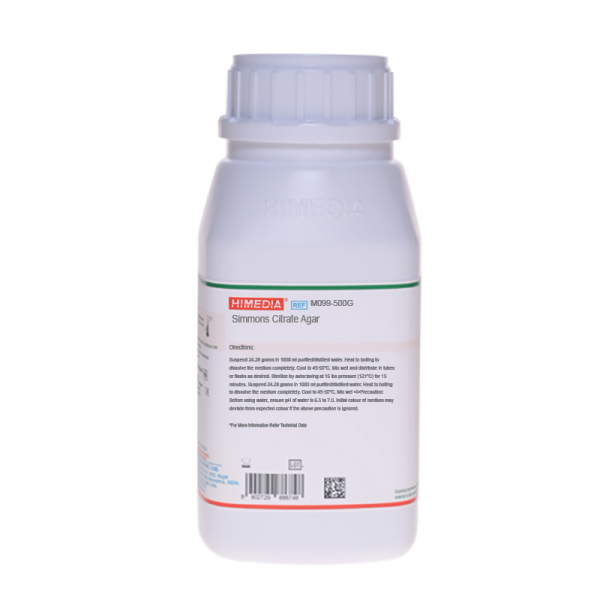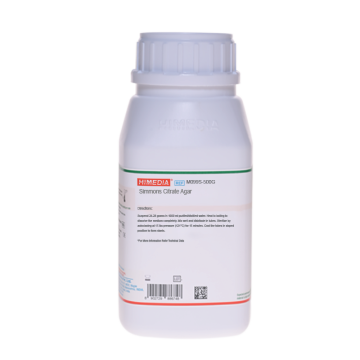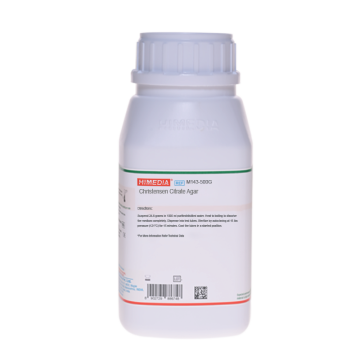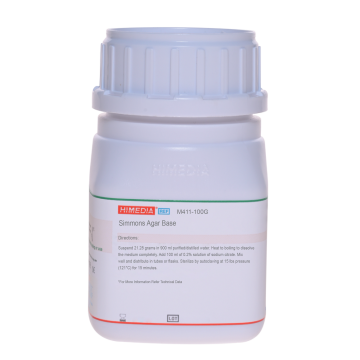 Your enquiry has been submitted
Your enquiry has been submitted
Simmons Citrate Agar
Yersinia enterocolitica#CC293D
Intended Use:
Recommended for differentiating members of Enterobacteriaceae from clinical and non-clinical samples on the basis of citrate utilization.
Composition**
| Ingredients | g/L |
|---|---|
| Magnesium sulphate | 0.200 |
| Ammonium dihydrogen phosphate | 1.000 |
| Dipotassium phosphate | 1.000 |
| Sodium citrate | 2.000 |
| Sodium chloride | 5.000 |
| Bromothymol blue | 0.080 |
| Agar | 15.000 |
Final pH (at 25°C): 6.8±0.2
**Formula adjusted, standardized to suit performance parameters
Directions
Suspend 24.28 grams in 1000 ml purified/ distilled water. Heat, to boiling, to dissolve the medium completely. Mix well and distribute in tubes or flasks. Sterilize by autoclaving at 15 lbs pressure (121°C) for 15 minutes.
Precaution: Before using water, ensure pH of water is 6.5 to 7.0. Initial colour of the medium may deviate from expected colour, if the above precaution is ignored.
Principle And Interpretation
These media are used for the differentiation between Enterobacteriaceae and the members of aerogenes group on the basis of citrate utilization as sole carbon source. Initially the citrate medium was developed by Koser (1) containing ammonium salt as the only nitrogen source and citrate as the only carbon source for differentiating Escherichia coli and Enterobacter aerogenes by IMViC tests. Later on Simmons (2) modified Kosers formulation by adding agar and bromothymol blue. It is recommended by APHA (3).
Ammonium dihydrogen phosphate and sodium citrate serve as the sole nitrogen and carbon source respectively. Microorganisms also use inorganic ammonium salts as their sole nitrogen source. Metabolism of these salts causes the medium to become alkaline, indicated by a change in colour of the pH indicator from green to blue. Bromothymol blue is the pH indicator. The medium should be freshly prepared because in dry conditions, changes in colour may appear even before inoculation, especially at the bottom of the slant.
Type of specimen
Isolated microorganism from clinical and non clinical samples.
Specimen Collection and Handling
For water samples, follow appropriate techniques for sample collection, processing as per guidelines and local standards (4).
For food and dairy samples, follow appropriate techniques for sample collection and processing as per guidelines (3,5,6).
For clinical samples follow appropriate techniques for handling specimens as per established guidelines (8,9).
After use, contaminated materials must be sterilized by autoclaving before discarding.
Warning and Precautions
In Vitro diagnostic use. For professional use only. Read the label before opening the container. Wear protective gloves/ protective clothing/eye protection/face protection. Follow good microbiological lab practices while handling specimens and culture. Standard precautions as per established guidelines should be followed while handling clinical specimens. Safety guidelines can be referred to in individual safety data sheets.
Limitations
- Before using water, ensure pH of water is 6.5 to 7.0.Initial colour of the medium may deviate from expected colour, if the above precaution is ignored.
- The pH affects the performance of the medium and must be correctly monitored.
Performance and Evaluation
Performance of the medium is expected when used as per the direction on the label within the expiry period when stored at recommended temperature.
Quality Control
Appearance Cream to yellow homogeneous free flowing powder.
Gelling Firm, comparable with 1.5% Agar gel
Colour and Clarity of prepared medium Forest green coloured slightly opalescent gel forms in tubes as slants.
Reaction Reaction of 2.43% w/v aqueous solution at 25°C. pH: 6.8±0.2.
pH 6.60-7.00
Cultural Response Cultural characteristics observed after an incubation at 35-37°C for 18-24 hours.
| Organism | Growth | Citrate utilisation |
|---|---|---|
| # Klebsiella aerogenes ATCC 13048 (00175*) | good-luxuriant | positive reaction, blue colour |
| Escherichia coli ATCC 25922 (00013*) | inhibited | negative reaction, green colour |
| Salmonella Typhi ATCC 6539 | fair-good | negative reaction, green colour |
| Salmonella Typhimurium ATCC 14028 (00031*) | good-luxuriant | positive reaction, blue colour |
| Shigella dysenteriae ATCC 13313 | inhibited | negative reaction, green colour |
| Salmonella Enteritidis ATCC 13076 (00030*) | good-luxuriant | positive reaction, blue colour |
Key: * Corresponding WDCM numbers # Formerly known as Enterobacter aerogenes
Storage and Shelf Life
Store between 10-30°C in a tightly closed container and the prepared medium at 2 - 8°C. Use before expiry date on the label.
On opening, product should be properly stored dry, after tightly capping the bottle in order to prevent lump formation due to the hygroscopic nature of the product. Improper storage of the product may lead to lump formation. Store in dry ventilated area protected from extremes of temperature and sources of ignition Seal the container tightly after use. Product performance is best if used within stated expiry period.
Disposal
User must ensure safe disposal by autoclaving and/or incineration of used or unusable preparations of this product. Follow established laboratory procedures in disposing of infectious materials and material that comes into contact with clinical sample must be decontaminated and disposed of in accordance with current laboratory techniques (7,8).
Reference
- Koser, 1923, J. Bact., 8:493.
- Simmons, 1926, J. Infect. Dis., 39:209.
- American Public Health Association, Standard Methods for the Examination of Dairy Products, 1978, 14th Ed., Washington D.C.
- Lipps WC, Braun-Howland EB, Baxter TE,eds. Standard methods for the Examination of Water and Wastewater, 24th ed. Washington DC:APHA Press; 2023.
- Salfinger Y., and Tortorello M.L., 2015, Compendium of Methods for the Microbiological Examination of Foods, 5th Ed., American Public Health Association, Washington, D.C.
- Wehr H. M. and Frank J. H., 2004, Standard Methods for the Microbiological Examination of Dairy Products, 17th Ed., APHA Inc., Washington, D.C.
- Isenberg, H.D. Clinical Microbiology Procedures Handbook. 2nd Edition.
- Jorgensen, J.H., Pfaller, M.A., Carroll, K.C., Funke, G., Landry, M.L., Richter, S.S and Warnock., D.W. (2015) Manual of Clinical Microbiology, 11th Edition. Vol. 1.
| Product Name | Simmons Citrate Agar |
|---|---|
| SKU | M099 |
| Product Type | Regular |
| Physical Form | Powder |
| Origin | Chemically defined (HiCynth™) |
| Packaging type | HDPE |
| References | 1. Koser, 1923, J. Bact., 8:493. 2.Simmons, 1926, J. Infect. Dis., 39:209. 3.MacFaddin J., 1985, Media for Isolation-Cultivation-Identification-Maintenance of Medical Bacteria, Vol. 1, Williams andWilkins, Baltimore. 4.Eaton A. D., Clesceri L. S., Rice E. W., and Greenberg A W., (Eds.), 2005, Standard Methods for the Examination of Waterand Wastewater, 21st Ed., APHA, Washington, D.C. 5.American Public Health Association, Standard Methods for the Examination of Dairy Products, 1978, 14th Ed., WashingtonD.C. 6.Salfinger Y., and Tortorello M.L. Fifth (Ed.), 2015, Compendium of Methods for the Microbiological Examination ofFoods, 5th Ed., American Public Health Association, Washington, D.C. 7.Baird R.B., Eaton A.D., and Rice E.W., (Eds.), 2015, Standard Methods for the Examination of Water andWastewater, 23rd ed., APHA, Washington, D.C. 8.Isenberg, H.D. Clinical Microbiology Procedures Handb0ook. 2nd Edition. 9.Jorgensen,J.H., Pfaller , M.A., Carroll, K.C., Funke, G., Landry, M.L., Richter, S.S and Warnock., D.W. (2015)Manual of Clinical Microbiology, 11th Edition. Vol. 1. 10.Wehr H. M. and Frank J. H., 2004, Standard Methods for the Microbiological Examination of Dairy Products, 17th Ed.,APHA Inc., Washington, D.C. |
| Customized Product Available | No |









